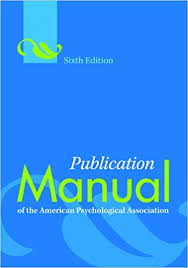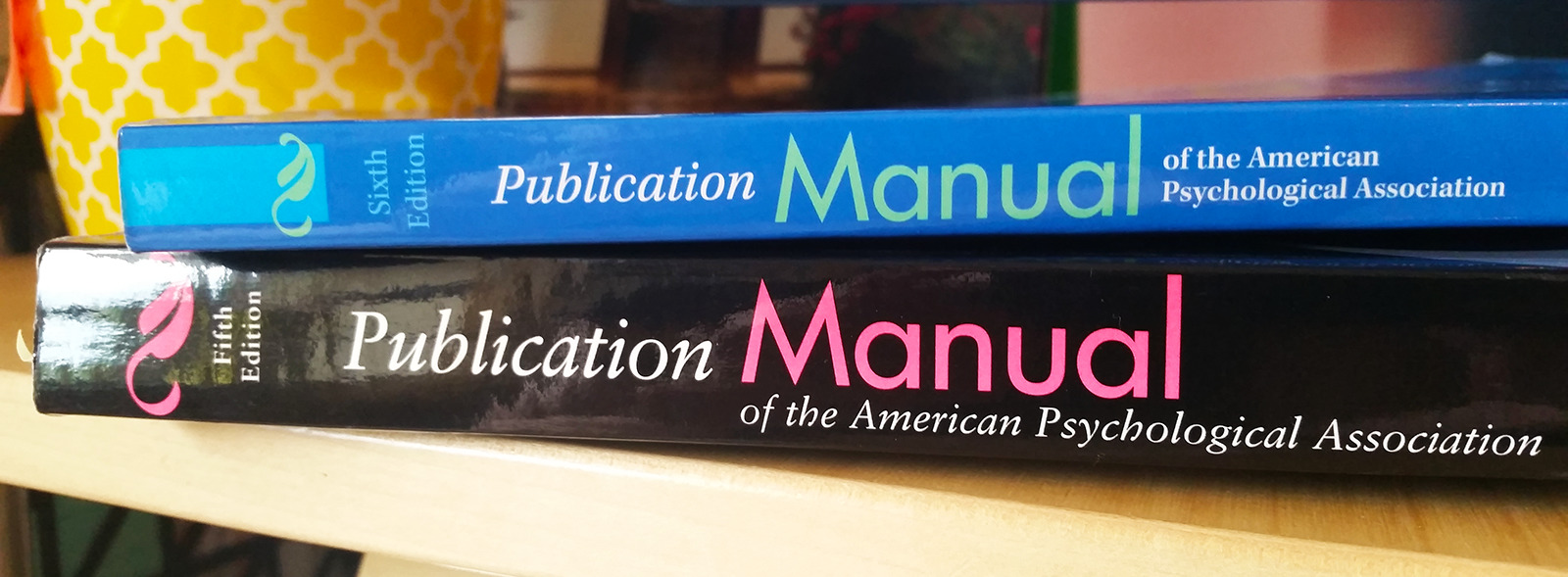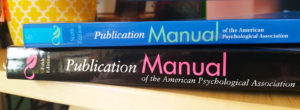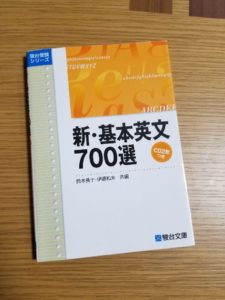米国心理学会(American Psychological Association)が発行しているPublication Manual of the American Psychological Association, 6th ed. (2011)を久しぶりに読み直しました。

いわゆるAPAスタイル (APA style)と言われるものです。1929年に出版され、現在、第7版が発行されています。日本語でも『APA論文作成マニュアル 第2版』が医学書院から出版されています。この論文作成マニュアルは心理学系論文だけでなく、社会科学、教育学、看護学などの様々な分野で定番のスタイルガイドとなっています。例えば、日本看護研究学会の原稿執筆要綱には
また、本学会の編集スタイルは、原則的に米国心理学会(American Psychological Association, APA)が発行している『Publication Manual of the American Psychological Association, 6th ed.』(2010)/『APA論文作成マニュアル第2版』〔2011、医学書院〕に準拠する。
と書かれています。本書の概要をつかみたい人は住 政二郎氏のLearning APA Style: Basicや立命館大学政策科学部の「APAスタイルによる英語ライティングのフォーマット方法」を読んでみましょう。英語のリスニング力がある人はBasics of APA Style Tutorialのビデオもお勧めです。
APAマニュアルは8章で構成されています。日本語版の目次は以下の通りです。
第1章 論文執筆にあたって
論文の種類
論文発表の倫理基準と法的基準
科学的知識の正確さの保証
研究参加者の権利の擁護
知的財産権の保護
第2章 論文原稿の構成と内容
学術論文報告基準
論文を構成する各セクション
論文原稿のサンプル
第3章 文章を簡潔・明瞭に書く技術
論文の構成
文章スタイル
偏見のない文章表現
偏見のない文章表現のための基本的ガイドライン
偏見のない文章表現のための項目別ガイドライン
文法と語法
第4章 論文スタイルの技巧
句読法
綴り
複合語表記の一般原則1
複合語表記の一般原則2
複合語表記の一般原則3
複合語表記の一般原則4
複合語表記の一般原則5
大文字使用
イタリック体
省略形
数
メートル法表示
統計や数式を含む原稿
等式
第5章 結果の表示
表と図の一般的な手引き
表
図
電気生理学,放射線学,その他の生物学的データの提示
第6章 引用と出典
引用を行なうべき時
引用と要約
本文中の文献引用
文献リスト
引用文献の構成要素
第7章 引用文献の表記例
参考資料(文献)の種類
タイプ別の用例
付録7.1 法的資料の引用
第8章 学術論文の出版プロセス
編集のプロセス
著者の責任
日本語でのAPAスタイルの解説は、そのほとんどがタイトル、アブストラクト、論文の構成、参考文献の書き方などの論文執筆のルールに焦点を当てています。しかし、APAスタイルは「受動態ではなく能動態で書け」といった準拠すべき英語の文章のルールについても細かく指示しています。以下、その中でも日本人が誤りがちな文章ルールを60ヶ所取り上げました。赤字が書くべきでない文、青字が模範文です。

日本人が誤りがちな60の英文ライティング
タイトルでありきたりの単語を使うな
タイトルではmethod (方法), results (結果), a study of… (~に関する研究), an experimental investigation of… (~についての実験的研究)といったありきたりの単語(情報量の低い単語)を使うな。タイトルで略語を使うな。12ワード以下にしろ。
Titles are commonly indexed and complied in numerous reference works. Therefore, avoid words that serve no useful purpose; they increase length and can mislead indexers. For example, the words method and results do not normally appear in a title, nor should such terms as A Study of or An Experimental Investigation of. … Avoid using abbreviations in a title; spelling out all terms helps ensure accurate, complete indexing of the article. The recommended length for a title is no more than 12 words. (p.23)
アブストラクトでの注意点
アブストラクトでは名詞ではなく動詞で表現しろ。an investigation of (~の研究)ではなく、…investigated (~を研究した)と書け。受動態ではなく能動態を使え。Results were presented (結果が提示された)ではなく、The authors presented the results (著者は結果を提示した)と書け。結論は現在形で書け。
Write in clear and concise language. Use verbs rather than their noun equivalents and the active rather than the passive voice (e.g., investigated rather than an investigation of; The authors presented the results instead of Results were presented). Use the present tense to describe conclusions drawn or results with continuing applicability. (p.26)
「AとBとC」は A, B, and C もしくは A; B; and C のどちらか
「AとBとC」の表現です。A・B・Cの中にコンマがない場合は、A・B・Cはコンマを使って仕分ける。
A, B, and C
A・B・Cの中にコンマがある場合は、A・B・Cはコンマではなくセミコロンを使って、
A; B; and C
と表現する。
Within a sentence, use commas to separate three or more elements that do not have internal commas; use semicolons to separate three or more elements that have internal commas.
We tested three groups: (a) low scorers, who scored fewer than 20 points; (b) moderate scorers, who scored between 20 and 50 points; and (c) high scorers, who scored more then 50 points. (p.64)

移行語(transitional word)を積極的に使え
移行語を積極的に使う。
関連を示す: then, next, after, while, since
因果関係を示す: therefore, consequently, as a result
追加を示す: in addition, moreover, furthermore, similarly
対比を示す: but, conversely, nevertheless, however, although
Another way to achieve continuity is through the use of transitional words. These words help maintain the flow of thought, especially when the material is complex or abstract. … Other transition devices are time links (then, next, after, while, since), cause-effect links (therefore, consequently, as a result), addition links (in addition, moreover, furthermore, similarly), and contrast links (but, conversely, nevertheless, however, although). (p.65)
時制をむやみに変えるな
時制をむやみに変えない。結果(results)は過去形で書く。結論(conclusion)は現在形で書く。
Results: Anxiety decreased significantly…
Conclusion: The results of Experiment 2 indicate that…
Abruptness may result from sudden, unnecessary shifts in verb tense within the same paragraph or in adjacent paragraph. By using verb tenses consistently, you can help ensure smooth expression. Past tense (e.g., “Smith showed”) or present perfect tense (e.g., “researchers have shown”) is appropriate for the literature review and the description of the procedure if the discussion is of past events. Stay within the chosen tense. Use past tense (e.g., “anxiety decreased significantly”) to describe the results. Using the present tense (e.g., “the results of Experiment 2 indicate”) to discuss implications of the results and to present the conclusions. By reporting conclusions in the present tense, you allow readers to join you in deliberating the matter at hand. (pp.65-6)
簡潔に書け
くどい言い回しをするな。
based on the fact that → because
at the present time → now
for the purpose of → for もしくは to
the present study → this study
several students who completed → several students completed (p.67)
冗長的な単語(以下、イタリックの単語)は切り捨てろ。
they were both alike
a total of 68 participants
four different groups saw
instructions, which were exactly the same as those used
absolutely essential
has been previously found
small in size
one and the same
in close proximity
completely unanimous
just exactly
very close to significance
period of time
summarize briefly
the reason is because (p.67)
文頭で副詞句のimportantly, more importantly, interestingly, firstlyを使うな。
代わりにmore important, firstを使え。
Some of the more common introductory adverbial phrases are importantly, more importantly, interestingly, and firstly. Although importantly is used widely, whether its adverbial usage is proper is debatable. Both importantly and interestingly can often be recast to enhance the message of a sentence or simply be omitted without a loss of meaning. (p.82)
Correct: More important, the total amount of available long-term memory activation, and not the rate of spreading activation, drives the rate and probability of retrieval.
Incorrect: More importantly, the total amount of available long-term memory activation, and not the rate of spreading activation, drives the rate and probability of retrieval.
Incorrect: Interestingly, the total amount of available long-term memory activation, and not the rate of spreading activation, drives the rate and probability of retrieval.
Correct: First, we hypothesized that the quality of the therapeutic alliance would be rated higher…
Incorrect: Firstly, we hypothesized that the quality of the therapeutic alliance would be rated higher…
(pp.82-3)
一文の長さにバリエーションをつけろ
Although writing only in short, simple sentences produces choppy and boring prose, writing exclusively in long, involved sentences results in difficult, sometimes incomprehensible material. Varied sentence length helps readers maintain interest and comprehension. (p.68)
短いシンプルな文章だけで書くと、ぎこちなくて退屈な文章になるが、長くて複雑な文章だけで書くと、難しく文章になったり、時には理解不能な文章になります。文章の長さにばらつきがあると、読者の興味と理解力を維持するのに役立ちます。
話し言葉を使うな
Avoid colloquial expressions (e.g., write up for report), which diffuse meaning. (p.68)
代名詞は何(or 誰)を指すか明確にしろ
例えば
this → this test
that → that trial
these → these participants
those → those reports
Pronouns confuse readers unless the referent for each pronoun is obvious; readers should not have to search previous text to determine the meaning of the term. Pronouns such as this, that, these, and those can be troublesome when they refer to something or someone in a previous sentence. Eliminate ambiguity by writing, for example, this test, that trial, these participants, and those reports. (p.68)
著者を3人称で表現するな
著者は自分たちのことなので1人称で表現する。
The authors reviewed the literature. → We reviewed the literature. (p.69)
動物や物や事象を擬人化するな
動物を人のように扱わない。
Rat couples (cage mates) were allowed to forage together. → Pairs of rats (cage mates) were allowed to forage together.
ただし動物に名前がついている時はhe, sheでもよい。
The chimps were tested daily. … Sheba was tested unrestrained in an open testing area, which was her usual context for training and testing. (p.80)
物や事象を人のように扱わない。
Incorrect: The community program was persuaded to allow five of the observers to become tutors.
Correct: The staff for the community program was persuaded to allow five of the observers to become tutors.
説得されるのは人であって、地域プログラムではありません。
An experiment cannot attempt to demonstrate, control unwanted variables, or interpret findings, nor can tables or figures compare (all of these can, however, show or indicate). Use a pronoun or an appropriate noun as the subject of these verbs. I or we (meaning the author or authors) can replace the experiment. (p.69)
論文でweを著者以外に使うな
例えば、日本人の経済学者である著者が「日本人」や「経済学者」を指す際に、weと言ってはいけない。論文でweは著者のことを指します。
For clarity, restrict your use of we to refer only to yourself and your coauthors (use I if you are the sole author of the paper). Broader use of we may leave your readers wondering to whom you are referring; instead, substitution an appropriate noun or clarify your usage.
Incorrect: We usually classify birdsong on the basis of frequency and temporal structure of the elements.
Correct: Researchers usually classify birdsong on the basis of frequency and temporal structure of the elements.
差別的表現をするな
年齢層は上限をちゃんと示す
To describe age groups, give a specific age range (“ages 65-83 years”) instead of a broad category (“over 65 years”). (p.71)
「老人」はelder, seniorという単語を使わずに、older adultsと書く
12歳以下はgirl, boy, 13歳から17歳まではyoung man, young woman, female adolescent, male adolescent, 18歳以上はwoman, man。老人はthe elderly, elderly people, elderly person, seniorという単語を使わず、older adultsとするのが望ましい。(p.76)
マイノリティ・グループは具体的な方がベター
Asian American → Chinese Americans
Hispanic American → Mexican American (p.71)
人種・エスニック集団の名前は固有名詞扱いなので単語の初めを大文字にすること
black → Black
white → White
片方が人種集団、もう一方がエスニック集団といったことのない様に気をつける
African Americans and Whites
Asian Americans and Black Americans
人種・エスニック集団を修飾語として使う時、複数語の名前にハイフンをつけるな
Asian-American participants → Asian American participants (p.75)
「同性愛者」という意味のgayという単語は男女双方に使う場合と男性のみに使う場合があるので気をつけろ
gays and lesbians → gay men and lesbians (p.71)
特定グループにレッテルを貼らない望ましい表現
the gays → gay men
the elderly → older adults
the amnesiacs → amnesic patients
the schizophrenics → people diagnosed with schizophrenia (p.72)
homosexualという単語を使わない。代わりにlesbians, gay men, bisexual men, and bisexual womenなどの表現をする
The terms lesbians, gay men, bisexual men, and bisexual women are preferable to homosexual when one is referring to people who identify this way. Lesbian, gay, and bisexual refer primarily to identities and to the culture and communities that have developed among people who share those identities. As such, the terms lesbians, gay men, and bisexual individuals are more accurate than homosexual. Furthermore, the term homosexuality has been and continues to be associated with negative stereotypes, pathology, and the reduction of people’s identities to their sexual behavior. Gay can be interpreted broadly, to include men and women, or more narrowly, to include only men. (pp.74-5)
男性のみでないのにhe/himを使うな
3人称単数の人称代名詞はhe-his-him, she-her-her, it-its-itですが、性別がわからないのにhe-his-himとしてはいけません。
対策①別の表現に言い換える
Incorrect: When an individual conducts this kind of self-appraisal, he is a much stronger person.
Correct: When an individual conducts this kind of self-appraisal, that person is much stronger.
対策②複数形にする
Incorrect: A therapist who is too much like his client can lose his objectivity.
Correct: Therapists who are too much like their clients can lose their objectivity.
対策③人称代名詞を冠詞に変える
Incorrect: A researcher must apply for his grant by September 1.
Correct: A researcher must apply for the grant by September 1.
対策④人称代名詞を外す
Incorrect: The researcher must avoid letting his own biases and expectations influence the interpretation of the results.
Correct: The researcher must avoid letting biases and expectations influence the interpretation of the results.
※heの代わりにhe or she, she or he, he/she, (s)heを使うことはあまり勧められない(たまにであればよい)。heとsheを交互に使う事も勧められない。(pp.73-4)
「障害者」は「~の障害を持った人」(person with…, people with…)という表現を使え
人を病名で表現するな。例えば、autistic(自閉症の人)やneurotic(神経症の人)。代わりにa person with autistic (1人の場合)、people with neurotic (複数の場合)という言い回しを使おう。the retarded (知恵遅れの人たち)はpeople with intellectual disabilitiesと言おう。
The overall principle for “nonhandicapping” language is to maintain the integrity (worth) of all individuals as human beings. Avoid language that objectifies a person by her or his condition (e.g., autistic, neurotic), that uses excessive and negative labels (e.g., AIDS victim, brain damaged), or that can be regarded as a slur (e.g., cripple, invalid). Use people-first language, and do not focus on the individual’s disabling or chronic condition (e.g., person with paraplegia, youth with autism). Also use people-first language to describe groups of people with disabilities. For instance, say people with intellectual disabilities in contrast to the retarded. (p.76)
できるだけ能動態で書け
Verbs are vigorous, direct communicators. Use the active rather than the passive voice, and select tense or mood carefully. (p.77)
Incorrect: The survey was conducted in a controlled setting.
Correct: We conducted the survey in a controlled setting.
※ただし解説文・説明文で、動作主体よりも行為の対象・受け手に焦点を当てる時は受動態を使ってもかまわない。
e.g., The speakers were attached to either side of the chair./ The President was shot.
関係代名詞の先行詞が人の時はthatを使うな
高校の英文法の授業で、「関係代名詞は先行詞が人のときはwho、ものや動物のときはwhich、thatは先行詞が人とものどちらでも使える」と習ったでしょうが、APAスタイルでは先行詞が人のときにthatを使うなと指示しています。
Use who for human beings; use that or which for nonhuman animals and for things. (p.79)
Incorrect: The students that completed the task successfully were rewarded.
Correct: The students who completed the task successfully were rewarded.
関係代名詞の制限用法でwhichを使うな
高校の英文法の授業で、「関係代名詞のwhichには制限用法と非制限用法があるが、thatには制限用法しかない」と習ったかと思います。そうなると制限用法ではwhichとthatのどちらを使ってもよいということになりますが、APAスタイルでは「制限用法ではthat、非制限用法ではwhich」という使い分けをするよう指示しています。つまり、「制限用法ではwhichを使うな!」という指示です。
That versus which. That clauses (called restrictive) are essential to the meaning of the sentence… Which clauses can merely add further information (nonrestrictive) or can be essential to the meaning (restrictive) of the sentence. APA prefers to reserves which for non-restrictive clauses and use that in restrictive clauses.
制限用法: The cards that worked well in the first experiment were not useful in the second experiment.
非制限用法: The cards, which worked well in the first experiment, were not useful in the second experiment.
Consistent use of that for restrictive clauses and which for nonrestrictive clauses, which are set off with commas, will help make your writing clear and precise. (p.83)
制限節ではthat、非制限節ではカンマで区切りwhichを一貫して使用することで、文章をより明確で正確なものにすることができる。
修飾語句は被修飾語の近くに置け
修飾語句は何を修飾しているか明確にするため、形容詞と副詞は被修飾語の近くに置く
Misplaced modifiers. Because of their placement in a sentence, misplaced modifiers ambiguously or illogically modify a word. You can eliminate misplaced modifiers by placing an adjective or an adverb as close as possible to the word it modifies.
Correct: Using this procedure, the investigator tested the participants.
Correct: The investigator tested the participants who were using the procedure.
Incorrect: The investigator tested the participants using this procedure. (p.81)
※最初の2文はこの手法を用いたのがinvestigatorというのがはっきりわかるが、最後の文ではこの手法を用いたのがinvestigatorとparticipantsのどちらかがよくわからない。
onlyという副詞はそれが修飾する単語の隣に置く。
Many writers have trouble with the word only. Place only next to the word or phrase it modifies.
Correct: These data provide only a partial answer.
Incorrect: These data only provide a partial answer. (p.81)
※onlyがa partial answerを修飾する場合はa partial answerの直前にonlyを置くべき。
懸垂分詞を使うな
修飾語の意味上の主語が主節の主語と一致していないものを懸垂修飾語句(dangling modifier)と言います。ほとんどの人が聞いたことがないでしょうが、高校の英文法のクラスで懸垂分詞(dangling participle)を習ったはずです。分詞の主語が本文の主語と違うのにそれを明示していない分詞構文を懸垂分詞といいますが、懸垂修飾語句のほとんどが懸垂分詞の形をとります。懸垂分詞は文学的な表現以外では使わないようにしましょう。論文英語では御法度です。受動態ではなく能動態で表現することで懸垂分詞をつい使ってしまうミステイクを避けることができます。
Dangling modifiers. Dangling modifiers have no referent in the sentence. Many of these result from the use of the passive voice. By writing in the active voice, you can avoid many dangling modifiers. (p.81)
Correct: Using this procedure, I tested the participants.
Incorrect: The participants were tested using this procedure. (p.81)
Incorrect: Congruent with other studies, Mulholland and Williams (2000) found that this group performed better. (p. 82)
※最初の文ではこの手法を用いたのが私であることは明確。2つの文はこの手法を用いたのは参加者(the participants)ではないので、誰がこの手法を用いたのかが不明。後の文ではcongruent with other studies (他の研究と合致する)は、MulhollandとWilliamsではないので、何が他の研究と合致するのかが不明。
hopefullyをI hopeもしくはit is hopedという意味で使うな
hopefullyをI hope… (私は~を望む)、it is hoped… (~を期待されている)という意味で使わないこと。
Another adverb often misused as an introductory or transitional word is hopefully. Hopefully means “in a hopeful manner” or “full of hope”; hopefully should not be used to mean “I hope” or “it is hoped.”
Correct: I hope this not the case.
Incorrect: Hopefully, this is not the case. (p.83)
接続詞のwhileをalthoughという意味で使うな
接続詞のwhileは「~する間」もしくは「~と同時に」という意味にのみ使う。althoughという意味で使わない。
Use while to link events occurring simultaneously; otherwise, use although, and, or but in place of while.
Correct: Bragg (1965) found that participants performed well while listening to music.
Bragg (1965)は、参加者が音楽を聴きながら良いパフォーマンスをしていることを発見した。
Correct: Although these findings are unusual, they are not unique.
これらの発見したものはまれではあるが、ユニークではない。
Incorrect: While these findings are unusual, they are not unique.
Correct: The argument is purely philosophical, but the conclusion can also yield an empirical hypothesis, amenable to empirical investigation.
議論は純粋に哲学的であるが、その結論は経験的調査に適した経験的仮説を生み出すこともできる。
Incorrect: While the argument is purely philosophical, the conclusion can also yield an empirical hypothesis, amenable to empirical investigation.
(p.84)
接続詞sinceをbecauseという意味で使うな
接続詞sinceは「~以来」という意味にのみ使う。becauseという意味で使わない。
Since is more precise when it is used to refer only to time (to mean “after that”); otherwise, replace it with because.
Correct: Several versions of the test have been developed since the test was first introduced. (pp.83-4)
このテストが初めて導入されて以来、いくつかのバージョンが開発されてきた。
Correct: Data for two participants were incomplete because these participants did not report for follow-up testing.
2人の参加者のデータは、これらの参加者が追跡検査について報告しなかったため不完全であった。
Incorrect: Data for two participants were incomplete since these participants did not report for follow-up testing. (p.84)
従位節で等位接続詞を使った文では従位接続詞のthatを使い惜しむな
従位接続詞thatが使われる文で、従位節でand, but, or notなどの等位接続詞が出てくるときは、thatを省略しない。
To enhance the reader’s understanding, present parallel ideas in parallel or coordinate form. Make certain that all elements of the parallelism are present before and after the coordinating conjunction (i.e., and, but, or, nor).
Correct: The results show that such changes could be made without affecting error rate and that latencies continued to decrease over time.
その結果、このような変化がエラー率に影響を与えることなく行うことができ、潜伏は時間の経過とともに低下し続けることが分かった。
Incorrect: The results show that such changes could be made without affecting error rate and latencies continued to decrease over time. (p.84)
等位接続詞をペアで使った文での間違い諸々
Between and and
Correct: We recorded the difference between the performance of subjects who completed the first task and the performance of those who completed the second task.
我々は、最初の課題を完了した被験者の成績と、2番目の課題を完了した被験者の成績の差を記録した。
Incorrect: We recorded the difference between the performance of subjects who completed the first task and the second task. (p.85)
※the differenceは異なる課題を完了した被験者の成績についてであって、最初の課題を完了した被験者の成績と2番目の課題についてではない。
Correct: between 2.5 and 4.0 years of age
2.5歳から4.0歳の間
Incorrect: between 2.5–4.0 years of age (p.85)
Both and and
Correct: The names were difficult both to pronounce and to spell.
その名前は発音もつづりも難しかった。
Incorrect: The names were both difficult to pronounce and spell. (p.85)
Neither and nor
Correct: Neither the responses to the auditory stimuli nor the responses to the tactile stimuli were repeated.
聴覚刺激に対する反応も触覚刺激に対する反応も繰り返さなかった。
Incorrect: Neither the responses to the auditory stimuli nor to the tactile stimuli were repeated. (p.85)
Either and or
Correct: The respondents either gave the worst answer or gave the best answer.
or
The respondents gave either the worst answer or the best answer.
回答者は最悪の回答をしたか、最高の回答をしたかのどちらかである。
Incorrect: The respondents either gave the worst answer or the best answer. (pp.85-6)
※後者はeitherの位置がおかしいです。
Not only and but also.
Correct: It is surprising not only that pencil-and-paper scores predicted this result but also that all other predictors were less accurate.
驚くべきことに、紙と鉛筆のスコアがこの結果を予測しただけでなく、他のすべての予測因子の精度がそれよりも低かった。
Incorrect: It is not only surprising that pencil-and-paper scores predicted this result but also that all other predictors were less accurate. (p.86)
※後者はnot onlyの位置がおかしいです。
「AとBとC」の表現。A, B and Cではなく A, B, and Cと書け
Correct: the height, width, or depth in a study by Stacy, Newcomb, and Bentler (1991)
Incorrect: in a study by Stacy, Newcomb and Bentler (1991) (p.88)
※イギリス英語では、「A, B and C」になります。要するにこれはイギリス式で論文を書くなという指示です。
2つの独立節を結ぶ等位接続詞の前にはコンマを置け。
Correct: Cedar shavings covered the floor, and paper was available for shredding and nest building. (p.89)
杉の削りくずが床を覆い、紙は裁断や巣作りに利用できた。
Incorrect: Cedar shavings covered the floor and paper was available for shredding and nest building.
※後の文は「杉の削りくずが床と紙を覆った」と意味で読んだ後にbe動詞が続いているのを見て、やっとandが単語の連結ではないと判断できます。前の文よりわかりにくいです。
文中の「月・日・年」の後にはコンマを置け
Correct: April 18, 1992, was the correct date.
Incorrect: April 18, 1992 was the correct date.
ただし、「月・年」の後にはコンマを置きません。
Correct: April 1992 was the correct month. (p.89)
Incorrect: April 1992, was the correct month.
コロンの後に主語・動詞のある完全な文が続くときは大文字から、そうでない場合は小文字から始めろ
For example, Freud (1930/1961) wrote of two urges: an urge toward union with others and an egoistic urge toward happiness.
例えば、フロイト (1930/1961) は2つの衝動について書いている。他者との結合への衝動と幸福への利己的衝動である。
They have agreed on the outcome: Informed participants perform better than do uninformed participants. (p.90)
情報を与えられた参加者の方が、情報を与えられていない参加者よりもパフォーマンスが良いという結果に彼らは同意している。
皮肉、スラング、造語を強調したいときはダブル・クオーテーション・マークを一回目につけ、それ以降はつけるな
to introduce a word or phrase used as an ironic comment, as slang, or as an invented or coined expression. Use quotation marks the first time the word or phrase is used; thereafter, do not use quotation marks.
日本語の文章では強調したい単語にかぎかっこをつけますが、日本語の論文を英訳する際に、このかぎかっこの箇所をすべてダブル・クオーテーション・マークにしている英語論文をたまに見かけます。ダブル・クオーテーション・マークをつけるのは1回目だけなので注意してください。
Correct: the “good-outcome” variable … the good-outcome variable [no quotation marks after the initial usage]
Incorrect: the “good-outcome” variable … the “good-outcome” variable (p.91)
専門用語や重要語を強調したいときはイタリックにしろ。ダブル・クオーテーション・マークをつけるな
Correct: The term zero-base budgeting appeared frequently in the speech.
Incorrect: The term “zero-base budgeting” appeared frequently in the speech.
Correct: She compared it with meta-analysis, which is described in the next section. (p.91)
Incorrect: She compared it with “meta-analysis”, which is described in the next section.
信頼区間の下限と上限は角かっこでくくれ
95% Cls [-7.2, 4.3], [9.2, 12.4], and [-1.2, -0.5] (p.94)
スペルに不安があった時はMerriam-Webster’s Collegiate Dictionary (2005)で正しいスペルを確認しろ
Webster’s Collegiateに目当ての単語が載っていない場合はWebster’s Third New International Dictionary (2002)で確認する。(p.96)
ハイフンとダッシュ(em dashとen dash)の前後にスペースを置くな
■ hyphen: Use no space before or after (e.g., trial-by-trial differently).
■ em dash: An em dash is longer than a hyphen or an en dash and is used to set off an element added to amplify or to digress from the main clause (e.g., Studies─published and unpublished─are included). Use no space before or after an em dash. If an em dash is not available on your keyboard, use two hyphens with no space before or after.
■ en dash: An en dash is longer and thinner than a hyphen yet shorter than an em dash and is used between words of equal weight in a compound adjective (e.g., Chicago–London flight). Type as an en dash or, if the en dash is not available on your keyboard, as a single hyphen. In either case, use no space before or after.
日本の高校・大学の英語授業ではハイフンとダッシュの用法をちゃんと教えないので、ハイフンとダッシュの使い方がわからない人は多いかと思います。ちゃんとマスターしたい人は以下の3つの記事をお読みください。



マイナス記号はen dashと同じ長さで、en dashより少し太く、横棒を少し高い位置に置け
マイナス記号がワープロになかったら、ハイフンを利用せよと指示しています。その際、両サイドにスペースを置いてください。
A typeset minus sign is the same length as an en dash, but it is slightly thicker and slightly higher. If a minus sign is not available in your word-processing program, use a hyphen with a space on both sides (e.g., a – b). (p.97)
capitalization(単語の最初の文字を大文字にすること)のルールを守れ
タイトルではすべての動詞、名詞、形容詞、副詞、代名詞をキャピタライゼーションする。その他の品詞は4文字以上の場合のみキャピタライゼーションする。ハイフンで結ばれた複合語はどちらもキャピタライゼーションする。コロンやダッシュの後の最初の単語はキャピタライゼーションする。
In his book, History of Pathology
The criticism of the article, “Attitudes Toward Mental Health Workers”
“Ultrasonic Vocalizations Are Elicited From Rat Pups”
“Memory in Hearing-Impaired Children: Implications for Vocabulary Development” (p.101
タイトルの大文字ルールについては以下の記事を参照してください。

参考文献のリストでのタイトルは文頭、コロンとエムダッシュの後の単語、固有名詞のみキャピタライゼーションする。ハイフンで結ばれた複合語の後の単語はキャピタライゼーションしない
In titles of books and articles in reference lists, capitalize only the first word, the first word after a colon or em dash, and proper nouns. Do not capitalize the second word of a hyphenated compound.
Liu, D., Wellman, H. M., Tardif, T., & Sabagh, M. A. (2008). Theory of mind development in Chinese children: A meta-analysis of false-belief understanding across cultures and languages. Developmental Psychology, 44, 523-531. doi:10.1037/0012-1649.44.2.523
Cantor, A. B. (1996). Sample-size calculations for Cohen’s kappa. Psychologial Methods, 1, 150-153. doi:10.1037.1082-989X,1.2.150
(p.102)
数字が後に続く単語のキャピタライゼーションのルール
後に数字が続く場合は前の単語の最初の文字を大文字にする。ただし、本や表の共通部分を示す名詞はキャピタライゼーションをしない。
Capitalize nouns followed by numerals or letters that denote a specific place in a numbered series.
On Day 2 of Experiment 4
during Trial 5, the no-delay group performed
as shown in Table 2, Figure 3B, and Chapter 4
Grant AG02726 from the National Institute on AgingException: Do not capitalize nouns that denote common parts of books or tables followed by numerals or letters.
page iv
row 3
column 5 (p.103)
文中での書名や雑誌名はイタリックにするが、その中にタイトル名があれば元に戻せ
Words within the title of a book in text that would normally be italicized should be set in Roman type (this is referred to as reverse italicization)
Dreaming by the Book: Freud’s The Interpretation of Dreams and the History of the Psychoanalytic Movement (p.104)
※青字すべてがタイトルですが、そのタイトルの中にフロイトの著作である『夢判断』(The Interpretation of Dreams)が含まれています。タイトル内のタイトル名はイタリックにしません。
ただの強調のために単語をイタリックにするな
Do not use italics for mere emphasis (Italics are acceptable if emphasis might otherwise be lost; in general, however, use syntax to provide emphasis.)
Incorrect: it is important to bear in mind that this process is not proposed as a stage theory of developments. (p.106)
略語を乱用するな
To maximize clarity, use abbreviations sparingly. Although abbreviations are sometimes useful for long, technical terms in scientific writing, communication is usually garbled rather than clarified if, for example, an abbreviation is unfamiliar to the reader. (p.106)
わかりやすくするために、略語は控えめに使ってください。略語は科学的な文章を書く際に、長い専門用語を略するのに時に有用ですが、例えば略語が読者になじみのないものである場合、コミュニケーションは通常、明確になるどころか逆に不明瞭になります。
Abbreviations introduced on first mention of a term and used fewer than three times thereafter, particularly in a long paper, may be difficult for a reader to remember, and you probably serve the reader bet if you write them out each time. (p.107)
特に長い論文で、用語の最初の言及時に導入された略語がその後2回以下しか使われないと、読者はその略語を覚えておくのは難しいかもしれないし、その単語が出るたびに略しないでちゃんと書く方が読者にはわかりやすいだろう。
In general, use an abbreviation only (a) if it is conventional and if the reader is more familiar with the abbreviation than with the complete form or (b) if considerable space can be save and cumbersome repetition avoided. In short, use only those abbreviations that will help you communicate with your readers. Remember, they have not had the same experience with your abbreviations as you have. (p.107)
一般的に、略語は以下の時にのみ使用してよい。(a) それが慣用的であり、かつ読者が完全な形よりもその略語をよく知っている場合、または(b) かなりのスペースを節約でき、面倒な繰り返しを避けることができる場合。つまり、読者とのコミュニケーションに役立つ略語だけを使おう。読者は、あなたと同じようにその略語に出会ったことがあるわけではないことを忘れてはいけない。
カッコ内でのみ以下の短縮形を使ってよい。カッコ以外ではラテン語の英語訳を使え。必要なピリオドとコンマは省略せずに正しく使え。
Use the following standard Latin abbreviations only in parenthetical material; in non-parenthetical material, use the English translation of the Latin terms; in both cases, include the correct punctuation that accompanies the term:
cf. compare
i.e., that is,
e.g., for example,
viz., namely,
, etc. , and so forth
vs. versus, against (p.108)
10以上の数は数字で書け、9以下はアルファベットで書け
one, two, three, four, five, six, seven, eight, nine, 10, 11, 12, 13…
1を超えることがありうる1未満の数値は小数点の前に0を書け
Use a zero before the decimal point with numbers that are less than 1 when the statistic can exceed 1.
0.23 cm
Cohen’s d = 0.70
0.48 s
1を超える数値があり得ない場合は、小数点の前に0を書くな
Do not use a zero before a decimal fraction when the statistic cannot be greater than 1 (e.g., correlations, proportions, and levels of statistical significance).
r(24) = -.43
p = .028
シンボルと数字の間にスペースを置け(角度を除く)
Use a space between a symbol and the number to which it refers, except for measures of angles (e.g., degrees, minutes, and seconds)
4.5 m
12 ℃
45° angle
信頼区間の書き方
When reporting confidence intervals, use the format 96% CI [LL, UL], where LL is the lower limit of the confidence interval and UL is the upper limit.
信頼区間を報告する場合は、96% CI [LL, UL]という形式を使用します。LLは信頼区間の下限で、ULは上限です。
95% CIs [5.62, 8.31], [-2.43, 4.31], and [-4.29, -3.11], respectively (p117)
数式をスペースなしで書くな
Space mathematical copy as you would space words: a+b=c is as difficult to read as wordswithoutspacing. Instead, type a + b = c. (p.118)
Correct: a + b = C
Incorrect: a+b=C
引用文が40ワード以上超える場合はブロック型引用をしろ。その際、クオーテーションマークはつけず、字下げしろ
If the quotation comprises 40 or more words, display it in a freestanding block of text and omit the quotation marks. Start such a block quotation on a new line and indent the block about a half inch from the left margin (in the same position as a new paragraph). If there are additional paragraphs within the quotation, indent the first line of each an additional half inch. Double-space the entire quotation. At the end of a block quotation, cite the quoted source and the page or paragraph number in parentheses after the final punctuation mark. (p.171)
引用文が40語以上の場合は、独立したテキストブロックに表示し、引用符を省略する。このようなブロック型引用は改行して、左マージンから約0.5インチ(新しい段落と同じ位置)インデントする。引用文内にさらに段落がある場合は、それぞれの最初の行を0.5インチインデントする。引用文全体はダブルスペースで書く。ブロック型引用の最後には、最後の句読点の後に、括弧をつけて引用元とページ番号または段落番号を引用する。
引用文の単語の初めを大文字から小文字に変えること(その逆も)、シングル・クオーテーション・マークをダブル・クオーテーション・マークに変えること(その逆も)、この2つは勝手にしてかまわない。
The first letter of the first word in a quotation may be changed to an uppercase or a lowercase letter. The punctuation mark at the end of a sentence may be changed to fit the syntax. Single quotation marks may be changed to double quotation marks and vice versa. Any other changes (e.g., italicizing words for emphasis or omitting words…) must be explicitly indicated. (p.172)
引用文の最初の単語の最初の文字を大文字または小文字に変更できる。文末の句読点は、構文に合わせて変更できる。シングルクォーテーションマークをダブルクォーテーションマークに変更できるし、その逆も可能である。その他の変更(例えば、強調のために単語をイタリック体にしたり、単語を省略することなど)は、そうしたことを明示的に示す必要がある。
引用文の1文を省略するときは . . . 。2文以上の時は . . . .。
)
Use three spaced ellipsis points (. . .) within a sentence to indicate that you have omitted material from the original source. Use four points to indicate any omission between two sentences. The first point indicates the period at the end of the first sentence quoted, and the three spaced ellipsis points follow. Do not use ellipsis points at the beginning or end of any quotation unless, to prevent misinterpretation, you need to emphasize that the quotation begins or ends in midsentence. (pp.172-3)
元のソースから文章等を省略したことを示すために、文章内に間隔を空けた3つの省略符号(. . .)を使え。2つの文の間に省略があった場合は、4つの省略符号を使え。最初の句点は、引用された最初の文の最後にあるピリオドを示し、間隔を空けた3つの省略符号がそれに続く。誤解を防ぐために、引用文が文の途中で始まったり終わったりしていることを強調する必要がある場合を除き、引用文の最初や最後に省略記号を使うな。
引用文に追加説明をする時は丸かっこではなく、角かっこを使え
Use brackets, not parentheses, to enclose material such as an addition or explanation inserted in a quotation by some person other than the original author.
原著者以外の人が引用文に挿入された追加や説明などを囲む場合は、丸かっこではなく、角かっこを使え。
Correct: “They are studying, from an evolutionary perspective, to what extent [children’s] play is a luxury that can be dispensed with when there are too many other competing claims on the growing brain . . .” (Henig, 2008, p. 40). (p.173)
引用文の中の単語を強調したいときはイタリック体にし、その後に[emphasis added]という表現を加えろ
If you want to emphasize a word or words in a quotation, italicize the word or words. Immediately after the italicized words, insert within brackets the words emphasis added, that is, [emphasis added]. (p.173)
引用文中の単語や語句を強調したい場合は、その単語や語句を斜体にしろ。その斜体の語句のすぐ後に[emphasis added]を挿入せよ。
共著者の引用ルール。2人の時は常にどちらとも表記せよ。3人以上の時は最初だけ全員の名前を表記し、2回目以降は筆頭著者の名前の後は et al. と書け
When a work has two authors, cite both names every time the reference occurs in text. When a work has three, four, or five authors, cite all authors the first time the reference occurs; in subsequent citations, include only the surname of the first author followed by et al. (not italicized and with a period after al) and the year if it is the first citation of the reference within a paragraph. (p.175)
著者が2人の場合、本文中で言及されるたびに両方の名前を引用する。著者が3人、4人、または5人の場合、最初に言及されたときにすべての著者を引用し、その後の引用では、ファーストオーサーの苗字の後にet al.(イタリック体ではなく、alの後にピリオドがある)をつけ、それが段落内の最初の引用の場合は出版年を記載する。
4人の著者で最初に引用されたとき
Kisangau, Lyaruu, Hosea, and Joseph (2007) found…
2回目以降に引用されたとき
Kisangau et al. (2007) found…
同じ段落内で2回目以降の引用のとき
Kisangau et al. found…
(p.175)
共著者の最後の名前の前の and は丸カッコ内、テーブル、キャプション、参考文献では & と書け
Precede the final name in a multiple-author citation in running text by the word and. In parenthetical material, in tables and captions, and in the reference list, join the names by an ampersand (&):
as Kurtines and Szapocznik (2003) demonstrated
as has been shown (Joreskog & Sorbom, 2007) (p.175)
引用文を引用するときは引用後に (as cited in 著者名, 出版年) を表記せよ
Use secondary sources sparingly, for instance, when the original work is out of print, unavailable through usual sources, or not available in English. Give the secondary source in the reference list; in text, name the original work and give a citation for the secondary source. For example, if Allport’s work is cited in Nicholson and you did not read Allport’s work, list the Nicholson reference in the reference list. In the text, use the following citation:
Allport’s diary (as cited in Nicholson, 2003). (p.178)
例えば、元の作品が絶版になっていたり、通常のソースでは入手できなかったり、英語版がない場合、二次的なソースは控えめに使用すること。参照リストに二次ソースのみを載せ、本文中では原著作物のタイトルを挙げ、二次資料の引用をすること。例えば、Allportの著作がNicholsonの著作で引用されていて、あなたがAllportの著作を読んでいない場合は、参考文献にNicholsonの引用文献を記載すること。本文では、以下のように引用すること。
Allport’s diary (as cited in Nicholson, 2003).
参考文献はダブルスペースでぶら下げインデント(段落の第1行が他の行より突き出るようなインデント)で表記せよ
APA requires that the reference list be double-spaced and that entries have a hanging indent. (p.180)
参考文献で表記オーケーの略称
| Abbreviation | Book or public part |
| ed. | edition |
| Rev. ed. | Revised edition |
| 2nd ed. | second edition |
| Ed. (Eds.) | Editor (Editors) |
| Trans. | Translator(s) |
| n.d. | no date |
| p. (pp.) | page (pages) |
| Vol. | Volume (as in Vol. 4) |
| Vols. | Volumes (as in Vols. 1-4) |
| No. | Number |
| Pt. | Part |
| Tech. Rep. | Technical Report |
| Suppl. | Supplement |
書籍や雑誌の巻数はローマ数字ではなくアラビア数字で表記すること
Although some volume numbers of books and journals are given in Roman numerals, APA journals use Arabic numerals (e.g., Vol. 3, not Vol. III) because they use less space and are easier to comprehend than Roman numerals. A Roman numerals that is part of a title should remain Roman (e.g., Attention and Performance XIII). (p.180)
書籍や雑誌の巻数がローマ数字で表記されることがあるが、APAのジャーナルではアラビア数字を使用している(例えば、Vol. IIIではなくVol. 3)。アラビア数字の方がローマ数字よりもスペースが少なく、わかりやすいためだ。タイトルの一部であるローマ数字はそのままにしておけ(例えば, Attention and Performance XIII)。
出版年がわからない文献は (n.d.) と表記せよ
If no date is available, write n.d. in parentheses. (p.185)







